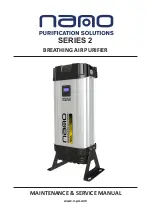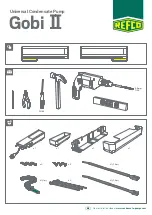
4
v
English
L-2086 Introduction
DX Remote & Self-Contained A/C Systems • Introduction
Warning
This manual contains essential information concerning
the safe and proper installation and operation of your
Cruisair air conditioning system. If there are any state-
ments or procedures in this manual that you do not un-
derstand, contact the Dometic Corporation Applications
Department for assistance. Phone
804-746-1313 (8 am - 5 pm US Eastern Time),
Fax 804-746-7248, or email [email protected].
Notice
US federal law prohibits the intentional release of refrig-
erant gases into the environment, including the R -22 re-
frigerant used in most Cruisair air conditioning systems.
Special care must be taken when installing, charging,
and servicing Cruisair equipment to prevent any loss of
equipment. Only EPA certified technicians with the prop-
er equipment should perform service on the refrigerant
circuit of the system.
Drawings and Diagrams
The figures that are referenced throughout this manual can be
found immediately after the warranty section of the manual. In
addition, some Cruisair equipment will be shipped with specific
installation sheets or wiring diagrams that may supercede the
information located in this manual.
Air Conditioning Basics
The basic principle of an air conditioner is the movement of
heat. In a direct expansion (DX) water-cooled air conditioner,
heat is transferred from the cabin air to the refrigerant gas,
which then releases the heat into the seawater. In reverse cycle
heating (heat pump), the refrigerant flow is reversed and heat
is extracted from the seawater and then discharged into the
cabin.
The heat exchange process relies on the movement of both
cabin air and seawater to effectively work. If air flow or seawa-
ter flow is compromised, the efficiency of the system will drop,
and the unit could eventually be damaged, or at least shut
down on one of its safety protection devices.
Part of the cooling process, in addition to lowering the air tem-
perature, is the removal of moisture from the air. This lowers
the humidity, which makes the area feel more comfortable and
helps keep the boat dry, reducing mold growth and other mois-
ture related problems.
The Effect of Seawater Temperature
The efficiency of the system is dependent on both the seawater
and cabin temperatures. In cooling, the air conditioner works
best when the seawater temperature is below 90°F (32°C). At
higher water temperatures the unit will operate, but at reduced
capacity. As the water temperature rises, so does the refriger-
ant gas pressure. A high-pressure safety switch will shut the
unit down if the water temperature gets too hot, or there is a
loss of cooling water flow.
In heat mode, the opposite is true. As the seawater tem-
perature gets colder, there is less heat available and heating
performance drops. Full heating capacity is available in water
temperatures as low as 55°F (13°C), but drops to about 50%
capacity in 40°F (4.4°C) water. Below this, the refrigerant pres-
sure can be so low that the unit will not produce heat, (or may
shut down on low-pressure fault, if this option is installed).
Types of DX Systems
Self-contained units have all major mechanical compo-
nents of an air conditioning system mounted on one chassis,
including the compressor, seawater condenser, evaporator coil,
blower, electrical box and related parts.
The self-contained unit is normally mounted low in the living
area - under a settee or berth, or in a closet or locker. Cabin
air is pulled into the unit, where it is cooled or heated, then dis-
charged through ducting to a grill usually located on a bulkhead
high in the compartment.
The refrigerant circuit in a self-contained unit is pre-charged
and sealed at the factory, and no additional charging is needed
at installation. A typical self-contained unit is shown in Figure 1.
Remote systems, also called split-gas, have the air condition-
ing components mounted on two separate chassis that are
installed in different locations and are connected by copper
refrigerant tubing.
The condensing unit consists of the compressor, seawater
condenser, and electrical components, and is mounted in the
engine room or other mechanical space.
The cooling/heating unit includes the evaporator coil and a
fan or blower mounted on a drip pan. It is installed in the living
area in a similar manner to a self-contained unit. Two or three
cooling/heating units can be connected to one condensing unit
so that multiple or large cabins can be cooled.
A remote system must be charged with refrigerant after instal-
lation by a certified technician. A typical condensing unit is
shown in Figure 2, and Figure 3 is a typical draw-through type
cooling/heating unit.
Содержание DX Remote & Self-Contained A/C
Страница 2: ......
Страница 23: ...23 L 2086 Fig 12 Plenum Configurations Fig 11 Duct and Grill Sizes Tables ...
Страница 24: ...24 L 2086 Fig 13a Switch Dimensions and Templates ...
Страница 25: ...25 L 2086 Fig 13b Switch Dimensions and Templates ...
Страница 26: ...26 L 2086 Fig 14 SHR5 16 StowAway Wiring 082611 Fig 15 SH24C StowAway Wiring 080264 ...
Страница 29: ...29 L 2086 Fig 20 WFAH6 16 Condensing Unit Wiring 082201 Fig 21 R F20 60C 1 Ph Cond Unit Wiring 082534 ...
Страница 30: ...30 L 2086 Fig 22 R F24 72 3 Ph Cond Unit Wiring 082556 Fig 23 SA3 Z Switch Wiring ...
Страница 31: ...31 L 2086 Fig 25 PR3X Pump Relay Wiring Fig 24 SA5 Z Switch Wiring ...
Страница 32: ...32 L 2086 Fig 26 PR8X Pump Relay Wiring Fig 27 WFAH System Wiring 115V ...
Страница 33: ...33 L 2086 Fig 28 WFAH System Wiring 230V Fig 29 WFAH System Wiring 230V w Aux Heat ...
Страница 34: ...34 L 2086 Fig 30 R F Type System Wiring SA3 Z Switch 1Ph Fig 31 R F Type System Wiring SA3 B Switch 1Ph ...
Страница 35: ...35 L 2086 Fig 32 R F Type System Wiring SA3 Z Switch 3Ph ...
Страница 36: ...36 L 2086 Fig 33 Refrigerant Charging Curves R22 ...
Страница 38: ...NOTES ...
Страница 39: ...NOTES ...





































